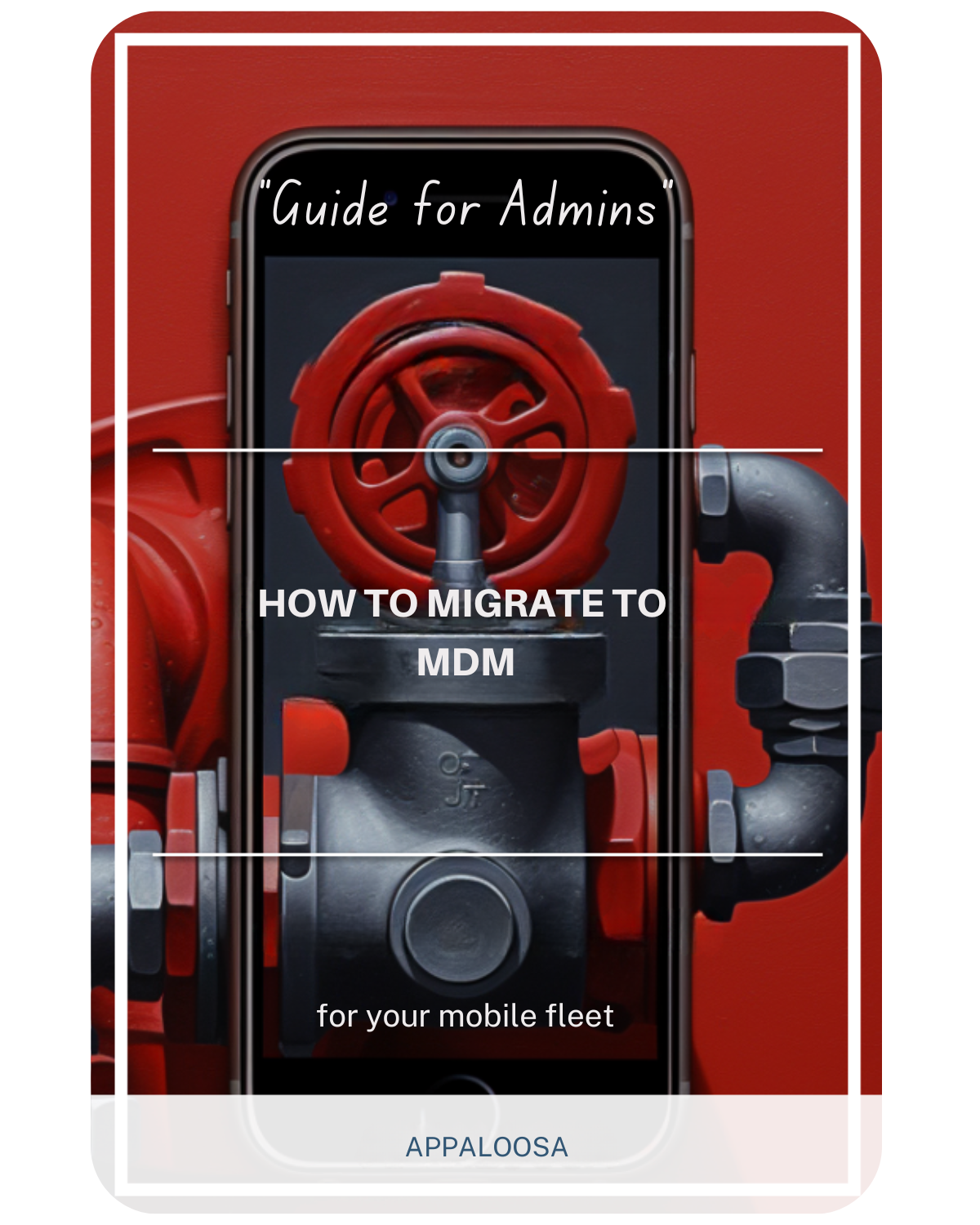Definition of COPE: Corporate-Owned, Personally Enabled

In today's rapidly evolving digital workplace, organizations face the challenge of balancing employee flexibility with the need to protect sensitive company data.
The def of COPE (Corporate-Owned, Personally Enabled) represents a strategic approach to mobile device management that addresses this challenge by allowing employees to use corporate owned devices for both work and limited personal tasks.
What Does COPE Stand For in Mobile Device Management?
What is the meaning of COPE? COPE stands for Corporate-Owned, Personally Enabled. It represents a mobile device management (MDM) approach that has gained popularity in recent times.
The COPE up definition encompasses a comprehensive strategy where organizations provide employees with COPE devices that can be used for both professional and personal purposes under controlled conditions.
COPE mobile device management is a model where organizations purchase, provision, and maintain devices while permitting employees to use them for specific personal activities.
Unlike traditional corporate owned business only (COBO) models that strictly prohibits personal use, COPE offers a balanced approach that enhances employee satisfaction while maintaining corporate control.
This model differs significantly from BYOD (Bring Your Own Device) and represents a middle ground in modern management strategies.
Under COPE MDM, the organization acts as the property owner of all devices, maintaining full control over security protocols, software updates, and COPE data management while still providing employees with the flexibility they desire.
How COPE Manages and Supports Business Operations
The COPE model manages and supports organizational needs through several key mechanisms that work together to create a comprehensive mobile device strategy. Each COPE device in the organization's fleet becomes part of a larger ecosystem designed to balance security with usability.
Device Provisioning and Maintenance
Organizations implementing COPE are responsible for managing the devices throughout their entire lifecycle. This includes initial setup, ongoing maintenance, software updates, and eventual replacement.
The IT department typically handles all technical aspects, ensuring devices remain secure and functional for business operations. This centralized management approach allows for consistent security policies across all COPE devices and simplified troubleshooting processes.
Data Security and Separation
A critical aspect of COPE MDM is how it handles the separation between corporate and personal data. Through Enterprise Mobility Management EMM solutions, organizations can create secure containers that isolate business applications and data from personal content.
This separation ensures that sensitive corporate information remains protected while respecting employee privacy. The containerization technology allows employees to maintain personal photos, messages, and applications on their COPE device without compromising corporate security requirements.
Policy Enforcement
COPE implementations rely on comprehensive acceptable use policies (AUPs) that clearly define what personal activities are permitted on company owned devices. These policies typically outline approved personal applications, acceptable browsing behaviors, data storage limitations, privacy expectations, and consequences for policy violations.
The key to successful policy enforcement in mobile device management MDM lies in striking a balance between being comprehensive enough to protect the organization while remaining flexible enough to accommodate reasonable personal use.
Comparing COPE with Other Management Models
Understanding how COPE fits within the broader landscape of mobile device management requires examining related models and their distinct characteristics. The COPE up definition becomes clearer when contrasted with other approaches.
CYOD (Choose Your Own Device)

The choose your own device model offers employees a selection of pre-approved corporate devices. While similar to COPE in that the organization owns the devices, CYOD focuses more on device choice than usage flexibility.
Many organizations combine elements of both approaches to create hybrid solutions that maximize both employee satisfaction and operational efficiency. The key difference is that while CYOD emphasizes selection, COPE MDM emphasizes usage flexibility.
The CYOD COPE and COBO Spectrum
CYOD COPE and COBO represent different points on the mobile device management spectrum, each with unique advantages and limitations. COBO offers maximum security but minimal flexibility, making it suitable for high-security environments but potentially frustrating for employees.
COPE balances security with personal use allowances, creating a middle ground that works well for many organizations. CYOD emphasizes employee choice in device selection, which can improve adoption rates and user satisfaction.
BYOD provides maximum flexibility but poses significant security challenges that many organizations find difficult to manage effectively.
Benefits of COPE for Modern Organizations
The advantages of implementing a COPE strategy extend beyond simple device management, touching multiple aspects of organizational operations and employee relations.
Understanding what does COPE stand for in practical terms means recognizing these comprehensive benefits.
Enhanced Security and Compliance
Organizations own and control COPE devices. This allows for strong security measures. These measures include end-to-end encryption, remote wipe options, required security updates, and following industry rules.
This level of control is particularly important for organizations operating in regulated industries or handling sensitive customer data. The ability to enforce consistent security policies across all devices significantly reduces the risk of data breaches and compliance violations.
Cost Efficiency
While requiring initial investment in COPE device procurement, COPE often proves cost-effective through bulk purchasing discounts, standardized support processes, reduced help desk tickets, and predictable replacement cycles.
Organizations can negotiate better rates with device manufacturers and service providers when purchasing in volume. Additionally, the standardization of devices and configurations reduces the complexity and cost of IT support, as technicians become experts in managing a limited set of device models and configurations.
Improved Employee Satisfaction
By allowing limited personal use, COPE MDM addresses a key employee desire while maintaining corporate control. This balance often results in higher adoption rates, reduced shadow IT, better work-life integration, and increased productivity.
Employees appreciate not having to carry multiple devices or switch between personal and work phones throughout the day. This convenience factor alone can significantly improve employee satisfaction and reduce resistance to corporate mobile device policies.

Implementation Challenges and Solutions
Despite its benefits, COPE implementation presents several challenges that organizations must address to ensure success. The COPE up definition includes understanding and overcoming these obstacles.
Initial Investment and Infrastructure
The upfront costs of purchasing COPE devices and implementing EMM solutions can be significant. Organizations must budget for device procurement, EMM licensing, IT staff training, and policy development.
These initial costs can be particularly challenging for smaller organizations or those with limited IT budgets. However, many organizations find that the long-term benefits of mobile device management MDM, including reduced support costs and improved security, justify the initial investment.
Privacy Concerns
Employees may worry about employer access to personal data on their COPE device. Clear policies and technical controls that separate personal and corporate data help address these concerns.
Many EMM solutions now offer sophisticated containerization that provides strong privacy protections. Organizations must be transparent about what data they can access and under what circumstances. Building trust through clear communication and consistent policy enforcement is essential for successful COPE adoption.
Policy Development and Enforcement
Creating comprehensive yet understandable policies for COPE MDM requires collaboration between IT, HR, legal, and management teams. Policies must address acceptable personal use, data retention and deletion, monitoring and privacy boundaries, and disciplinary procedures. The challenge lies in creating policies that are detailed enough to cover various scenarios while remaining accessible and understandable to all employees. Regular training and communication help ensure employees understand and comply with these policies.
The Role of Insurance Coverage in COPE
An often-overlooked aspect of COPE implementation is insurance coverage. Organizations must ensure their policies adequately cover COPE device damage and loss, data breach liability, employee privacy violations, and third-party access incidents.
Working with insurance providers familiar with mobile device management MDM helps ensure comprehensive coverage that protects both the organization and its employees.
As COPE deployments grow in size and complexity, the potential financial impact of incidents increases, making appropriate insurance coverage increasingly important.
Best Practices for COPE Implementation
Successful COPE MDM implementation requires careful planning and execution across multiple organizational dimensions. Understanding what does COPE stand for in your specific context is crucial for success.
Start with Clear Objectives
Define what you hope to achieve with COPE by establishing specific goals for security improvements, cost reduction, employee satisfaction, and compliance requirements.
These objectives should align with broader organizational strategies and be measurable to allow for ongoing evaluation of the program's success. Consider how COPE devices will integrate with existing infrastructure and workflows.
Choose the Right EMM Solution
Select an EMM platform that supports your specific mobile device management MDM needs through robust containerization, user-friendly interface, comprehensive reporting, and scalability.
The chosen solution should integrate well with existing IT infrastructure and support future growth. Consider conducting pilot programs with different solutions before making a final selection.
Develop Comprehensive Policies
Create policies for COPE device usage that are clear and understandable, legally compliant, technically enforceable, and regularly updated.
Involve stakeholders from across the organization in policy development to ensure all perspectives are considered. Regular reviews and updates ensure policies remain relevant as technology and business needs evolve.
Provide Adequate Training
Ensure both IT staff and end-users understand the COPE up definition and its implications, including policy requirements, technical features, support procedures, and security best practices.
Training should be ongoing, with refreshers provided regularly and additional training offered when new features or policies are introduced.
Monitor and Adapt
Regularly review your COPE MDM implementation by analyzing usage patterns, gathering employee feedback, updating policies as needed, and adjusting technical controls.
This continuous improvement approach ensures the COPE program remains effective and aligned with organizational needs.
The Future of COPE
As workplace dynamics continue to evolve, COPE mobile device management is adapting to meet new challenges through technological advancement and changing organizational needs.
AI-Powered Management
Machine learning algorithms increasingly help automate policy enforcement for COPE devices, detect anomalous behavior, predict device failures, and optimize support resources.
These AI-driven capabilities reduce the administrative burden on IT teams while improving security and user experience.

Enhanced Privacy Technologies
New containerization and encryption methods for COPE device management provide stronger data separation, better performance, improved user experience, and greater privacy protection.
These advances address one of the primary concerns employees have about COPE programs while maintaining the security benefits organizations require.
Integration with Zero Trust Security
COPE MDM implementations increasingly incorporate zero trust principles including continuous authentication, least privilege access, micro-segmentation, and risk-based controls.
This integration provides additional security layers while maintaining the flexibility that makes COPE attractive to employees.
Conclusion
COPE mobile device management represents a pragmatic solution for organizations seeking to balance security, cost-efficiency, and employee satisfaction.
By allowing controlled personal use of corporate-owned devices, COPE addresses many limitations of traditional COBO approaches while avoiding the security challenges of BYOD.
Understanding what does COPE stand for and implementing it effectively can transform how organizations manage their mobile device ecosystems.
Success with COPE MDM requires careful planning, appropriate technology selection, comprehensive policies, and ongoing management. Organizations that invest in proper implementation often find that COPE not only enhances security and reduces costs but also improves employee satisfaction and productivity.
As the workplace continues to evolve, COPE will likely remain a popular choice for organizations seeking a balanced approach to mobile device management.
By staying informed about emerging technologies and best practices, organizations can ensure their COPE devices and overall implementations continue to meet both business and employee needs effectively.
The COPE up definition will continue to evolve, but its core principle of balancing corporate control with personal flexibility remains constant.
